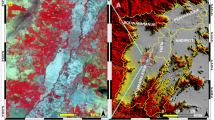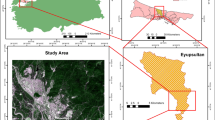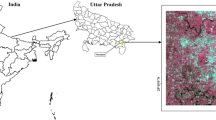Abstract
Monitoring urban land through satellite images has rapidly developed with the advent of modern technologies, and the increasing number of satellites plays a contributing role. While optical images have a high capability in urban monitoring, they still have some limitations, including their dependence on climatic conditions and spectral information, which lead to difficulty in making a distinction between bare land, buildings and other features. The impossibility of optical imagery at night is another issue that can make the land cover classification difficult. Synthetic aperture radar (SAR) allows imaging in all climatic conditions and at nighttime, with an ability to detect phenomena based on their geometry, roughness, and location, making the land cover classification much easier. In the present study, radar Sentinel-1 images with polarization VV and VH were used for the land classification in Tabriz. Sentinel-2 images for the same time were applied as a reference for the calibration and accuracy assessment. Maximum likelihood (ML) and support vector machine (SVM) algorithms were also employed for supervised classification. In both algorithms, the classification was performed in windows with different sizes once by the SAR backscattering coefficient (σ0) and then by combining the backscattering coefficients with the statistical data obtained from the texture. The results showed that the use of radar images only with backscattering intensity resulted in poor performance while using the gray-level co-occurrence matrix (GLCM) of texture features increased the accuracy. The transmitted frequencies of radar images have different redistributions to different phenomena. The numerical results obtained from the radar image classification show that using only the radar image redistribution led to low accuracies at both VV and VH polarization, but the use of the textural analysis significantly increased the accuracy of the classifications. The statistical results obtained from the ML and SVM classifications for radar images at VV and VH polarization indicated that the latter performed better than the former. When texture analysis was not used in the classes, the classification accuracy was low with kappa values of 0.37 and 0.42 for VV and VH polarization, respectively. The use of texture analysis and obtaining the optimum window size is increase the classification accuracy with a better performance for VH polarization. The SVM classification method with a kappa coefficient of 0.72% showed better performance than the ML one with a kappa coefficient of 0.61%. Conclusively, in the absence of Sentinel-2 datasets, Sentinel-1 images are good alternatives if the preserved texture information is available for the land cover classification. Results of this research are of great importance for developing the remote sensing methods and their techniques can be considered as progressive research in the domain of remote sensing sciences.













Similar content being viewed by others
References
Al-Ahmadi FS, Hames AS (2009) Comparison of four classification methods to extract land use and land cover from raw satellite images for some remote arid areas. Earth Sci 20(1):167–191
Anyamba A, Eastman JR (1996) Interannual variability of NDVI over Africa and its relation to El Nino/southern oscillation. Int J Remote Sens 71(3):2533–2548
Argenti F, Lapini A, Alparone T et al (2013) A tutorial on speckle reduction in synthetic aperture radar images.IEEE. Trans Geosci Remote Sens 1(3):6–35
Arxi P, Adibnejad M (2011) Internship experience of support vector machine algorithms for land use classification using ETM + Landsat satellite data (case study: Ilam dam area). Iranian J Range Desert Res 18(3):420–440
Augusteijn MF, Clemens LE, Shaw KA (1995) Performance evaluation of texture measures for ground cover identification in satellite images by means of a neural network classifier. IEEE Trans Geosci Remote Sens 33:616–626
Bhatta B (2010) Analysis of urban growth and sprawl from remote sensing data. Springer-Verlag
Bolstad PV, Lillesand TM (1992) Rule-based classification models: flexible integration of satellite imagery and thematic spatial data. Photogramm Eng Remote Sens 58(7):965–971
Campbell C, Ying Y (2011) Learning with support vector machines. In: Synthesis Lectures on Artificial Intelligence and Machine Learning. Morgan & Claypool
Cao H, Zhang H, Wang C et al (2018) Operational built-up areas extraction for cities in China using Sentinel-1 SAR data. Remote Sens 10(6):1–20
Cavur M, Duzgun HS, Kemec S et al (2019) Land use and land cover classification of Sentinel-2-a: ST Petersburg case study. International archives of the photogrammetry. Remote Sens Spatial InformaSci XLII-1(W2):16–17
Cavur M, Kemec S, Nabdel L, Duzgun HS (2017) An evaluation of land use land cover (LULC) classification for urban applications with Quickbird and WorldView2 data. Urban Remote Sens Event (JURSE) 1–4
Chang CC, Lin CJ (2013) LIBSVM: a library for support vector machines. ACM Trans Intell Syst 2(3):22
Chatziantoniou A, Psomiadis E, Petropoulos GP (2017) Co-orbital sentinel 1 and 2 for LULC mapping with emphasis on wetlands in a mediterranean setting based on machine learning. Remote Sens 9(12):1259
Chen CH, Pau LF, Wang PSP (1999) The handbook of pattern recognition and computer vision. World Scientific
Dell'Acqua F, Gamba P (2006) Discriminating urban environments using multiscale texture and multiple SAR images. Int J Remote Sens 12(18):3797–3812
Dixon B, Candade N (2008) Multispectral land use classification using neural networks and support vector machines: one or the other, or both. Int J Remote Sens 29(4):1185–1206
Du P, Samat A, Waske B et al (2015) Random Forest and rotation Forest for fully polarized SAR image classification using polarimetric and spatial features. ISPRS J Photogramm Remote Sens 105:38–53
Durgesh KS, Lekha B (2010) Data classification using support vector machine. J Theor Appl Info Technol 12(1):1–7
Feizizadeh, B., Kazamei, M., Blaschke, T., Lakes, T (2021) An object based image analysis applied for volcanic and glacial landforms mapping in Sahand Mountain, Iran, Catena, https://doi.org/10.1016/j.catena.2020.105073
Gamba P, Aldrighi M, Stasolla M (2011) Robust extraction of urban area extents in HR and VHR SAR images. IEEE J Select Topics Appl Earth Observ Remote Sens 4(1):27–34
Gonzalez RC, Woods ER (1992) Digital Image Processing. Addison Wesley, Boston
Gumma MK, Thenkabail PS, Hideto F, Nelson A, Dheeravath V, Busia D, Rala A (2011) Mapping irrigated areas of Ghana using fusion of 30 m and 250 m resolution remote-sensing data. Remote Sens 3(4):816–835
Haralick R, Shanmugan K, Dinstein I (1973) Textural features for image classification. StudMedia Commun SMC:610–621
Hashiba H, Kameda K, Uesugi S, Tanaka S (2000) Land-use change analysis of Tama of river basin with different spatial resolution sensor data by land sat MSS and TM. Adv Space Res 26(7):1069–1073
Hatami F (2001) Monitoring urban changes using remote sensing data ( case study: Kerman city ). University of Tehran, Tehran, pp 120–135
Hedge S (2003) Modeling land cover change: a fuzzy approach. Unpublished Thesis, ITC The Netherlands
Hsu CW, Chang CC, Lin CJ (2015) A practical guide to support vector classification. National Taiwan University Taipei 1396-1400
Huertas A, Gebejes R (2013) Texture characterization based on grey-level co-occurrence matrix. Conference of informatics and management sciences. Slovakia: Sci. 375-378
Hussain M, Chen D, Cheng A, Wei H, Stanley D (2013) Change detection from remotely sensed images: from pixel-based to object-based approaches. ISPRS J Photogramm Remote Sens 80:91–106
Jensen JR (2005) Introductory digital image processing: a remote sensing perspective. Prentice-Hall, NJ
Karimzadeh S, Miyajima M, Hassanzadeh R, Amiraslanzadeh R, Kamel B (2014) A GIS-based seismic hazard, building vulnerability and human loss assessment for the earthquake scenario in Tabriz. Soil Dyn Earthq Eng 66:263–280
Karimzadeh S, Matsuoka M, Ogushi F (2018) Spatiotemporal deformation patterns of the Lake Urmia causeway as characterized by multisensor InSAR analysis. Scientific Report 8:5357
Kazemi F (2013) Change detection approaches by using optical and SAR images. K.N.Toosi University of Technology, Tehran
Keshavarz A, Ghasemian Yazdi M (2005) A fast algorithm based on backup vector machine for classifying hyperspectral images using spatial correlation. Electrical engineering and computer engineering of Iran 37-44
Koch F, Krellenberg K (2018) How to Contextualize SDG 11? Looking at Indicators for Sustainable urban development in Germany. ISPRS Int Geo-Inform Sustain Develop Goals 7(12): 464
Kraak M, Ricker B, Engelhardt Y (2018) Challenges of Mapping Sustainable Development Goals Indicators Data. ISPRS Int Geo-Inform Sustain Develop Goals 7(12):482
Lardeux C, Frison PL, Tison C, Souyris JC, Stoll B, Fruneau B, Rudant JP (2009) Support vector machine for multifrequency SAR polarimetric data classification. IEEE Trans Geosci Remote Sens 47(12):4143–4152
Lazecky M, Comut FC, Qin Y et al (2017) Sentinel-1 interferometry system in the high-performance computing environment. In: Ivan I, Singleton A, Horák J, Inspektor T (eds) The rise of big spatial data. Springer, pp 131–139
Lee JS, Grunes MR, Pottier E (2001) Quantitative comparison of classification capability: fully polarimetric versus dual and single-polarization SAR. IEEE Trans Geosci Remote Sens 39(11):2343–2351
Lee JS, Grunes MR, Grandi GD (1999) Polarimetric SAR speckle filtering and its implication for classification. IEEE Trans Geosci Remote Sens 37(5):2363–2373
Lee JS (1986) Speckle suppression and analysis for synthetic aperture radar images. Opt Eng 25(5):255636
Lefebvre A, Sannier C, Corpetti T (2016) Monitoring urban areas with sentinel-2A data: application to the update of the Copernicus high resolution. Remote Sens 8(7):606
Lopes A, Touzi R, Nezry E (1990) Adaptive speckle filters and scene heterogeneity. IEEE Trans Geosci Remote Sens 28(6):992–1000
Maghsoudi Y (2015) Basics of remote sensing of radar. K. N. Toosi University of Technology
Mantero P, Moser G, Serpico SB (2005) Partial supervised classification of remote sensing images through SVM based probability density estimation. IEEE transactions. Geosci Remote Sens 43(3):559–570
Martensc B, Lambin EF (2000) Land-cover-change trajectories in southern Cameroon. Annals Am Assoc Geographers 90(3):467–494
Melchiorri M, Florczyk A, Freire S et al (2018) Megacities spatiotemporal dynamics monitored with the global human settlement layer. Real corp (CORP–competence Center of Urban and Regional Planning) 285-294
Maleknejad A, Ghasemian H, Mirzapour F (2015) Measurement of texture features in increasing the classification accuracy of images resulting from the integration of single-band and hyperspectral images of residential and industrial areas south of Tehran. J Geomatics Sci Technol 5(1):55–64
Molch K (2009) Radar earth observation imagery for urban area characterisation. JRC Scientific and Technical Reports; European Commission, Luxembourg, pp 1–9
Mosotti M, Campanini R (2008) Texture classification using invariant Ranklet features. Pattern Recogn Lett 29:1980–1986
Mohammadi A, Karimzadeh S, Valizadeh Kamran K, Matsuoka M (2020) Extraction of land information, future landscape changes and seismic Hazard assessment: a case study of Tabriz, Iran. Sensors 20(24):7010
Mountrakis G, Im J, Ogole C (2011) Support vector Machines in Remote Sensing. ISPRS J Photogramm Remote Sens 66(3):247–259
Najafi P, Feizizadeh B, Navid H (2021) A comparative approach of fuzzy object based image analysis and machine learning techniques which are applied to crop residue cover mapping by using Sentinel-2 satellite and UAV imagery. Remote Sens 13:937
Oommen T (2008) An objective analysis of support vector machine based classification for remote sensing. Math Geosci 40:409–424
Paneque-Gálvez J, Mas JF, Moré G, Cristóbal J, Orta-Martínez M, Luz AC, Guèze M, Macía MJ, Reyes-García V (2013) Enhanced land use/cover classification of heterogeneous tropical landscapes using support vector machines and textural homogeneity. Int J Appl Earth Obs Geoinf 23:372–383
Pohl C, Van Genderen JL (1998) Review article multisensor image fusion in remote sensing: concepts, methods, and applications. Int J Remote Sens 19(5):823–854
Radoux J, Chomé G, Jacques DC, Waldner F, Bellemans N, Matton N, Lamarche C, d’Andrimont R, Defourny P (2016) Sentinel-2’s potential for sub-pixel landscape feature detection. Remote Sens 8(6):488
Rezaei Motlag A, Shahriari G, Ebrahimi A et al. (2012) Classification of satellite images based on texture-based models using the neural network. Iran Electrical and Electronics News Conference, Gonabad Islamic University: 1486–1483
Richards JA (2013) Remote Sensing Digital Image Analysis, 5th edn. Springer, Berlin, pp 192–195
Shalaby A, Tateishi R (2007) Remote sensing and GIS for mapping and monitoring LC and land-use changes in the northwestern coastal zone of Egypt. Appl Geogr 27:28–41
Shao Y, Fan X, Liu H, Xiao J, Ross S, Brisco B, Brown R, Staples G (2001) Rice monitoring and production estimation using multitemporal RADARSAT. Remote Sens Environ 76(3):310–325
Shi Z, Fung KB (1994) A comparison of digital speckle filters. IGARSS'94. IEEE Int Geosci Remote Sens Symposium 4:2129–2133
Sim S, Im J, Park H et al (2018) Icing detection over East Asia from geostationary satellite data using machine learning approaches. Remote Sens 10(4):631
Sisodia PS, Tiwari V, Kumar A (2014) Analysis of supervised maximum likelihood classification for remote sensing image. International conference on recent advances and innovations in engineering 1-4
Skriver H (2012) Crop classification by multitemporal C- and L-band single- and dual-polarization and fully polarimetric SAR. IEEE Trans Geosci Remote Sens 50(6):2138–2149
Small C, A. A. Okujeni S, Linden VD et al (2018) Remote sensing of urban environments. Remote Sens 93:96–127
Sohrabi Mofrad M, Kia B (2020) Detecting impervious urban surfaces using the textural properties of radar imagery. J Spatial Plann 10(1):85–104
Srivastava PK, Han D, Rico-Ramirez MA, Bray M, Islam T (2012) Selection of classification techniques for land use. Land cover change investigation. Adv Space Res 50(9):1250–1265
Srivastava D, Bhambhu L (2009) Data classification using support vector machine. J Theor Appl Inf Technol 12(1):1–7
Strahler H (1980) The use of prior probabilities in maximum likelihood classification of remotely sensed data. Remote Sens 66:135–163
Szuster BW, Chen Q, Borger M (2011) A comparison of classification techniques to support land cover and land use analysis in tropical coastal zones. Appl Geogr 31(2):525–532
Takeharu K, Shunji M (1997) The affection of the vegetation change on the eroded soil in south-east Asia, " Asian association remote sensing. 8
Touzi R (2002) A review of speckle filtering in the context of estimation theory. IEEE Trans Geosci Remote Sens 40(11):2392–2404
Tsai YH, Stow D, Chen HL, Lewison R, An L, Shi L (2018) Mapping vegetation and land use types in Fanjingshan National Nature Reserve using Google earth engine. Remote Sens 10(6):927
Tuia D, Volpi M, Mura D et al (2014) Automatic feature learning for Spatio-spectral image classification with sparse SVM. IEEE Trans Geosci Remote Sens 52(10):6062–6074
Vapnik V (1992) Principles of risk minimization for learning theory. In: Moody J, Hanson S, Lippmann R (eds) Advances in Neural Information Processing Systems, 4.Morgan Kaufmann, San Mateo, CA, pp 831–838
Vapnik V, Chervonenkis A (1991) The necessary and sufficient conditions for consistency in the empirical risk minimization method. Pattern Recognition, Image Anal 1(3):283–305
Waske B, Benediktsson JA (2007) Fusion of support vector machines for the classification of multisensor data. IEEE Trans Geosci Remote Sens 45(12):3858–3866
Wood D, Brown RJ, McNairn H (1998) Operational consideration in using RADARSAT data for agricultural monitoring. 20th Canadian remote sensing symposium, Calgary, Alberta Canada
Wu Q, Li HQ, Wang RS, Paulussen J, He Y, Wang M, Wang BH, Wang Z (2006) Monitoring and predicting land-use change in Beijing using remote sensing and GIS. Landsc Urban Plan 78(4):322–333
Xiao M, He Z, Jia Y (2007) Fusion of multisensor images based on the curvelet transform. Remotely Sensed Data Inform 67520:67529
Yu L, Porwal A, Holden EJ, Dentith MC (2012) Towards automatic lithological classification from remote sensing data using support vector machines. Comput Geosci 45:229–239
Zakeri H, Yamazaki F, Liu W (2017) Texture analysis and land cover classification of Tehran using polarimetric synthetic aperture radar imagery. Appl Sci 7(5):452
Zeng Y, Zhang Y, Van Genderen JL (2010) Image fusion for land cover change detection. Int J Image Data Fusion 1(2):193–215
Zhang H, Lin H, Li Y, Zhang Y, Fang C (2016a) Mapping urban impervious surface with dual-polarimetric SAR data: an improved method. Landsc Urban Plan 151:55–63
Zhang ZX, Wang X, Wen QK et al (2016b) Research progress of remote sensing application in land resources. Remote Sens 20(5):1243–1258
Zhang J, Li P, Wang J (2014) Urban built-up area extraction from Landsat TM/ETM+ images using spectral information and multivariate texture. Remote Sens 6(8):7339–7359
Zhang Y (1999) Optimization of building detection in satellite images by combining multispectral classification and texture filtering. Photogramm Remote Sens 54(1):50–66
Acknowledgements
The authors thank European Space Agency (ESA) for providing SAR Sentinel-1 and MSI Sentinel-2 images in this research.
Author information
Authors and Affiliations
Corresponding author
Additional information
Communicated by: H. Babaie
Publisher’s note
Springer Nature remains neutral with regard to jurisdictional claims in published maps and institutional affiliations.
Communicated by: H. Babaie
Rights and permissions
About this article
Cite this article
Ghasemi, M., Karimzadeh, S. & Feizizadeh, B. Urban classification using preserved information of high dimensional textural features of Sentinel-1 images in Tabriz, Iran. Earth Sci Inform 14, 1745–1762 (2021). https://doi.org/10.1007/s12145-021-00617-2
Received:
Accepted:
Published:
Issue Date:
DOI: https://doi.org/10.1007/s12145-021-00617-2




